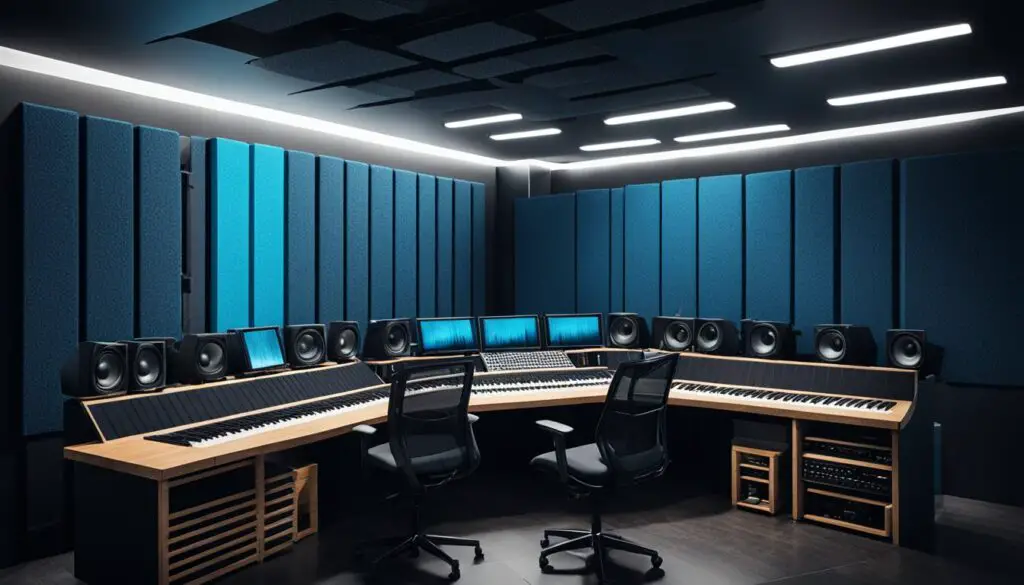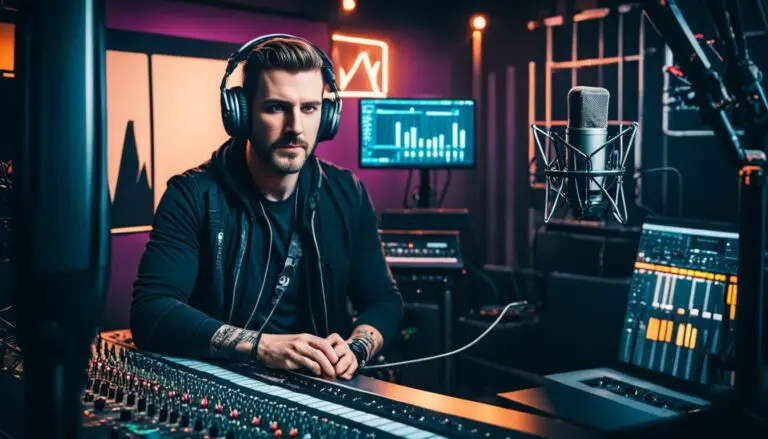Ever wondered how artists get that perfect sound in their bedroom? With the right know-how, making a top-notch demo at home is possible. We’ll show you what you need to know about producing sound, picking the best gear, and more. This guide will help you make a professional recording without leaving your house.
Recording a top-quality demo at home needs technical skill and creativity. It doesn’t matter if you love pop, rock, hip-hop, or jazz. You can bring out the best in your music with the right insights. In this guide, we’ll cover what you need to create exceptional recordings at home. This ensures your music gets the attention it deserves.
Key Takeaways
- Understanding the full recording process is crucial for creating a professional sound.
- Proper selection of equipment forms the bedrock of a studio-quality demo.
- Creative songwriting and a good ear for music go hand-in-hand with technical skills.
- Home recording offers artistic control and flexibility in your music creation process.
- Quality recordings can be achieved regardless of genre with the right approach and techniques.
Choosing the Right Equipment for Your Home Recording Studio
Choosing the best recording gear is key to studio-quality sound at home. It’s important to select the right equipment for your audio production. We will cover essential gear, microphones, accessories, and the needed audio interfaces and computer specs.

Essential Gear
For a home recording equipment, you need top-notch microphones and audio interfaces. The Audio-Technica AT2020 is both affordable and great for professional sound. It works well for making music and podcasts. Also, having quality DAW software such as Pro Tools or Ableton Live is essential.
- Microphones: Audio-Technica AT2020, Shure SM7B
- Headphones: Beyerdynamic DT 770 Pro, Audio-Technica ATH-M50x
- Studio Monitors: KRK Rokit 5, Yamaha HS5
Microphones and Accessories
Good microphone setups capture the details in your performance. Using accessories like pop filters and shock mounts can improve recording quality. The Shure SM7B is great for vocals and podcasts. An Audio-Technica AT2035 is fantastic for picking up details.
- Pop filters
- Shock mounts
- Microphone stands
Audio Interface and Computer Requirements
An audio interface links your microphone to your DAW software. The Focusrite Scarlett 2i2 provides high sound quality and the needed preamps. Your computer should be powerful enough to run your DAW smoothly. We recommend an i5 processor with 8GB RAM for the best results.
Picking the right equipment for your home recording studio is crucial. From microphones to DAW software, choosing wisely will help you create studio-quality music at home.
Optimising Your Recording Space
To get professional sound in your home studio, you need to focus on your space. This means making your room’s acoustics work in your favour. Tackle common issues to boost the sound quality of your recordings.
Importance of Acoustically Treating Your Room
Having a room that’s acoustically treated is key for top-notch recordings. Bad room acoustics can mess up your sound with reflections and standing waves. Fixing these problems helps you create a place that backs high-quality recordings.
Types of Acoustic Treatments
Acoustic panels, bass traps, and diffusers are crucial for sound treatment. Panels absorb mid to high tones, cutting down echo and reverb. Bass traps help manage corner-low frequencies for a smoother sound. Using all these treatments creates a balanced audio environment.

- Acoustic Panels: Effective for absorbing mid to high frequencies.
- Bass Traps: Designed to tackle low-frequency issues.
- Diffusers: Scatter sound waves, reducing comb filtering and flutter echo.
Setting Up a Vocal Booth
Getting a vocal booth can level up your vocal recordings. It isolates the voice, cutting out room noise and echo. This setup is perfect for getting clear, pro vocals.
Focus on these key factors to boost your recording space for better sound. Using acoustic panels, bass traps, and a proper vocal booth makes your recordings top quality. It’s the foundation for great audio work.
Studio-Quality Music, From Home
Creating studio-quality music at home is more than loving tunes. It’s about detail and getting things right for a professional sound. While the home setting is chill, you still need to use the best audio production methods.
First, make your space perfect for recording. Use things like panels and bass traps to catch sound well and cut distortions. Good equipment, like a top-notch microphone and interface, is crucial for excellence. Skills in mixing technology with music make the difference too.
In audio production, mixing and mastering are like skilled art. Doing this well puts each instrument in its best place, making the whole recording stand out. A good home studio not only provides comfort but also pushes musicians to give their top efforts.
Home recording opens a door to your studio every hour, letting you redo and try new sounds. To make studio-quality music, you must master every aspect of creating music. From setting up the room to the final touches, every detail builds towards a shining, professional sound.
| Aspect | Key Elements | Importance |
|---|---|---|
| Acoustics | Panels, Bass Traps | Reduces Distortion |
| Gear | Microphone, Audio Interface | Foundation for Quality |
| Techniques | Mixing, Mastering | Ensures Clarity |
| Creative Process | Experimentation, Repeated Takes | Inspires Performances |
Recording Techniques for Different Instruments
To get a great recording, you need to know how to record each instrument well. Every instrument has a special way to record it, for its unique sound.
Recording Vocals Effectively
Positioning your microphone right is key for good Vocal Performance. A cardioid condenser mic at a slight angle helps avoid strong sounds. It’s important to keep the mic at the same distance for a smooth sound. Pop filters and good room sound improve the recording even more.
Mic-ing Electric and Acoustic Guitars
There are different Mic Techniques for electric and acoustic guitars. For electric, a dynamic mic near the amp gives a strong sound. A condenser mic far away brings out more depth.
Acoustic guitars sound best with mics placed near the sound hole and the fretboard. This captures their full sound and detail well.
Recording Drums
Recording drums needs careful Mic Techniques. Each drum should have its own mic to get all the sounds right. Overhead mics catch cymbals and the drum set’s overall sound.
Close mics on snare, bass drums, and toms make sure the sound is full and even. Keeping microphone phases aligned maintains the drum mix’s sharpness and vitality.
Knowing the best ways to record instruments makes your audio project really stand out. Using these techniques well brings professional and high-quality sound to your work.
Importance of a Good Song Structure and Arrangement
A great song is more than just good sound. Its success depends a lot on how it’s Song Structure and arrangement are done. Memorable pieces have catchy tunes and a well-thought-out build.
Learning basic Composition Techniques helps. It makes your music’s chorus stick in people’s minds. It also adds feeling with smart chord changes.
Writing Engaging Melodies and Catchy Choruses
Getting the melody right is key in Melody Writing. It should capture and hold the listener’s ear. A chorus that’s easy to remember and fun to sing is crucial.
Using Composition Techniques can make your song unique. Mixing up speeds and notes gives your music a special touch.
Focus and Balance in Song Arrangement
Keeping Arrangement Balance is vital. Each sound and line must fit the song’s message. Placing everything just right ensures the main idea shines.
A clear Song Structure guides your listener’s feelings. This makes the song’s impact deeper.
Eliminating Unnecessary Elements
To sound professional, sometimes you must cut out the extra stuff. Too much going on can make your song messy. Focus on what’s key and remove what’s not.
Careful Melody Writing and structure together make songs that connect. Good balance and known Composition Techniques pull everything into a great song. This way, each part of your music works together for a powerful effect.
Monitoring Your Mix: Choosing the Right Studio Monitors
Choosing the right studio monitors is key for accurate sound. It helps during audio mixing. Proper speaker positioning and knowing room acoustics are important. This ensures mix transparency and informs our mixing decisions.
Speaker Size and Room Acoustics
Room size and acoustics are crucial when picking studio monitors. Larger spaces might need monitors with bigger drivers for more bass. Smaller rooms could use smaller monitors to avoid too much low frequency power. This balance is vital for precise sound reproduction, which allows for accurate mixing evaluations.
Proper Speaker Positioning
Speaker positioning is vital for accurate monitoring. Monitors should be at ear level for an exact stereo image. Also, keeping them away from walls helps reduce reflection issues. This improves mix transparency and the mixing space as a whole.
Setting Up an Equilateral Triangle
Creating an equilateral triangle between the monitors and your listening spot is trusted for top audio quality. This method ensures an equal distance between each monitor and the listener. It offers a balanced soundstage and boosts sound reproduction’s effectiveness.
| Factors | Recommendations |
|---|---|
| Monitor Size | Match with room size for balanced frequency response |
| Positioning | At ear level, away from walls |
| Triangle Setup | Equilateral triangle for optimal stereo imaging |
| Reflection Control | Use sound absorbers and bass traps |
Conclusion
Home studio success is achievable for all who dedicate themselves. The key is to choose the best gear like microphones and interfaces. Also, improving your recording space with sound treatments is vital.
Pay attention to how you record different instruments. Knowing about music structures makes a big difference too. It all pushes your music making to higher levels.
Even with just a home setup, creativity and skill can turn limits into chances. A finely-tuned recording space and careful sound capturing are key. Mixing well gets you the pro sound you dream of.
The music-making journey is a mix of art and tech, both equally important. Putting effort into every studio detail leads to success. Each step forward brings your home studio closer to professional quality.



